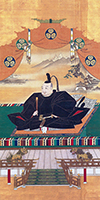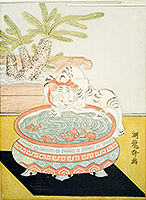FLOATING WORLD CULTURE
Week 1 Class Notes, 31 January 2019
The Edo Period
The Edo Period, also known as the Early Modern Period, lasted from 1600 (or 1603) to 1867 (or 1868). It was a period of peace and stability that followed a long period of civil war. There were two capitals: Kyoto where the Emperor lived and Edo where the Shogun lived. The period is also called the Early Modern Period or the Tokugawa Period after the dynasty of Tokugawa Shoguns who ruled Japan from 1600 until the 15th Tokugawa Shogun resigned in 1867.
Japan during the Edo Period did not include all of the islands that presently make up the country of Japan. It consisted of the islands of Honshu, Shikoku and Kyushu. Only the southern part of Hokkaido came under the influence of the Japanese government during this period.
Japan’s Historical Periods Prior to Edo Period:
Ancient up to 538
Diverse kingdoms unite under the rule of an emperor whose line continues through today. There is some contact with China.
Asuka 538 – 710
Asuka is the capital. There are diplomatic missions to China and Buddhism is introduced in the 6th century (the official date of the introduction is 552) along with written texts. Prince Shotoku Taishi (574-622), a devout Buddhist, introduces the Confucian model of rank, adopts the Chinese calendar, and sends envoys and students to China.
Nara 710 – 794
Heijo-kyo (now called Nara) becomes the capital. The first Japanese books are written and the oral history of earlier periods is recorded. Poetry anthologies are collected.
Heian 794 – 1185
The capital is moved to Heian-kyo (now called Kyoto). They expand their territory to include the northern part of Honshu. The phonetic kana writing system is developed. The Heian court produces great literary works of poetry, diaries, and fiction (much by women), most notably the Tale of Genji. Noble families set up private estates around the country and begin to build their own armies. Two families, the Taira and Minamoto, both descended from the imperial family, control significant areas and build large armies. In a dispute over succession in 1156 the Taira and Minamoto side with opposing candidates. This leads to an ongoing rivalry between the two clans and eventually the Genpei war, won in 1185 by the Minamoto at the naval Battle of Dan-no-ura.
Kamakura 1185 – 1333
Minamoto no Yoritomo, the leader of the Minamoto, makes Kamakura his capital. He rules with the Emperor in Kyoto and the Emperor declares him Shogun (Great General) in 1192. For the most part this is an era of prosperity. Great art is produced and more poetry anthologies compiled. Buddhism spreads throughout the country. The Kamakura government is more feudal in nature than the Heian and appoints provincial governors who are allowed significant independence and maintain their own armies. Japan is attacked by the Mongols in 1274 and again in 1281. The government calls for all samurai to resist the invasion, and they are successful, though in both instances they are assisted by the weather. The Mongols give up on the first invasion when a storm sinks many of their ships. During the second invasion the Mongol fleet is destroyed by a typhoon called kamikaze, or divine wind. The financial burden of resisting the Mongols weakens the government and Emperor Go-Daigo overthrows the Minamoto Shogun in 1333.
Muromachi 1333 – 1573
Emperor Go-Daigo isn’t strong enough to hold onto power and his main supporter, Ashikaga Takauji, places another member of the imperial family on the throne when Go-Daigo refuses to appoint him Shogun. Takauji makes Muromachi, a district of Kyoto, his capital. Go-Daigo sets up an alternate capital in Nara. In 1392 the country is reunited. Takauji appoints allies to rule the provinces and over time these feudal lords, now called Daimyo, become more powerful and independent.
This period saw the development of such distinctive Japanese arts as ikebana, the tea ceremony, bonsai, the Noh Theatre, and ink wash painting. It was also the period of first contact with Europeans when three Portuguese traders arrived in 1543 on board a Chinese ship.
The Onin War (1467-77), over the succession to the shogunate, weakens the central authority and leads to what is known as the Warring States period (c. 1467-1603).
The period between the Onin War and the beginning of the Edo Period is divided differently by different historians, depending on context. The most common period names in use are:
Azuchi-Momoyama 1573-1603
Sengoku c. 1467-1600
or Warring States c. 1467-1568 plus Unification 1568-1600 (I’ll use these)
Warring States c.1467 – 1568
Powerful Daimyo fight each other for control of the country. They employ spies called ninja. It is a period of shifting allegiances among the Daimyo and their samurai. More Portuguese traders follow the three who arrived in 1543. Among other things, they bring muskets, tobacco and Christianity.
Unification 1568 - 1600
Three powerful leaders bring about the unification of Japan. In 1568 Oda Nobunaga (1534-1582) takes control of Kyoto and eventually of most of Honshu. Nobunaga encourages Christianity in order to ally himself with the Portuguese and equip his armies with muskets. He promotes men regardless of their social status. Toyotomi Hideyoshi (1536-1598), the son of a peasant, becomes his greatest general and succeeds him when Nobunaga is assassinated.
In 1584 the Spanish arrive in Japan.
Hideyoshi succeeds in bringing all of Japan under his control in 1590. He disarms peasants and has the samurai move to castle towns. He introduces a rigid class hierarchy and bans slavery. Hideyoshi embarks on two unsuccessful invasions of Korea in the 1590s. He dies in 1598, leaving a 5 year old son with five regents. A struggle for power between one of the regents, Tokugawa Ieyasu (1542-1616), and those supporting Hideyoshi’s young son, Toyotomi Hideyori, ends with the Battle of Sekigahara in 1600. Tokugawa Ieyasu is victorious.
Tokugawa Ieyasu (1542-1616) and Tokugawa rule
Tokugawa Ieyasu’s victory at the battle Sekigahara in 1600 makes him the military ruler of Japan. Daimyo who resist him are exiled or forced to commit seppuku. The rest swear allegiance. In return they are allowed to keep control of their traditional domains, with the added proviso that they not attack or appropriate other territories, or conspire with others or with foreign powers against the Tokugawa government. Disputes are resolved by negotiation or by tribunal. The (approx. 260) Daimyo take care of regional administration.
Ieyasu makes Edo his capital. In 1603 the emperor, Go-Yozei (1572-1617), officially declares him Shogun. The Tokugawas ruled Japan for 14 generations, or 15 if you include the last, Tokugawa Yoshinobu, who became Shogun in 1866 and resigned at the end of 1867, without having really assumed power.
Initially there is some opposition to the Tokugawas: skirmishes in Osaka in 1614-15 and a 6-month uprising in the south-west in 1637. After that there is no armed resistance to Tokugawa rule.

Painting of Tokugawa Ieyasu, by Kano Tan’yu, c. early 1600s
Note that the novel Shogun, 1975, by James Clavell was set at the beginning of the Edo Period. His character Lord Toranaga was inspired by Tokugawa Ieyasu. The main character, John Blackthorne, was based on William Adams, the English pilot of a Dutch ship, who arrived in Japan in 1600.
The Floating World
There is much that was special and unique about the Edo Period, but one thing in particular was the tremendous growth of the city of Edo itself. By 1700 it had a population of about 1 million, making it one of the largest, if not the largest city in the world at that time. Within that population was a large number of people who made their living as artists, craftspersons, merchants, traders, etc. who were known collectively as chonin (townspeople).
Many of the chonin were prosperous, literate, and had time for leisure pursuits. This led to the development of a rich urban culture based on the arts and the pursuit of pleasure that came to be known as ukiyo, or the floating world. The elite disapproved of the floating world, viewing it as a sign of moral decay.

The Grand Courtesans Sugatano and Nanabito with Attendants, By Eisen, c.1830
Literacy in urban Japan increased dramatically through the 17th century, resulting in a thriving publishing industry. People could buy books or borrow them from a kashihon’ya (library) for a small fee. Books were available on a great many subjects, and fiction about and for the chonin became very popular. Much chonin literature was full of crude or obscene jokes and puns. The use of the term ukiyo (floating world) in the context of popular culture came from one of these novels, Ukiyo monogatari (Tales from the Floating World) by Asai Ryoi (1612-1691).
Asai Ryo was a Buddhist priest who became a popular writer of fiction about contemporary urban life. In Buddhism the term ukiyo referred to the transitory nature of life, and emphasized life’s hardships and sorrows, with the idea that one should concentrate on spiritual pursuits which would bring rewards in the afterlife. Asai used the term in an ironic way to refer to a life lived pursuing transitory pleasures, living for the moment without a thought for the future, let alone the afterlife:
“living just for the moment, focusing on the pleasure given by the moon, the snow, cherry blossoms, maple leaves, singing songs, drinking wine, diverting ourselves by just floating, floating, ignoring the pauperism that stares us in the face, refusing to be disheartened, floating like a gourd that drifts along with the river – this is what we call ukiyo.”
From Ukiyo Monogatari, c.1665

Beauty Reading, by Kunichika, 1878
Although Asai Ryo coined the term “ukiyo”, stories about the floating world were popularized by the author Saikaku Ihara (1642-1693). In 1682 he published The Life of an Amorous Man, the first of many fictional works about the lives of the chonin. Saikaku became one of the most popular writers of the Edo Period.
Floating World Art
In addition to books written for the chonin, there was art. The art that was produced for the chonin was called ukiyo-e, or floating world pictures. The most common format for ukiyo-e was the woodblock print, as this was relatively inexpensive to produce in large quantity. Individual woodblock prints first appeared at the end of the 17th century. They were sold in shops and by street vendors. This art was so popular during the Edo period that thousands of designs were produced and collected and fortunately a great many still exist today.
The most famous woodblock print from the Edo Period, the one that everyone has seen, is Under the Wave at Kanagawa by Hokusai (1760-1849), more commonly called “The Great Wave”.

Under the Wave at Kanagawa, by Hokusai, c.1830-32
Ukiyo-e subject matter
The subjects and images that are found in floating world art are quite similar to what you find on the internet today: a lot of pictures of celebrities, a lot of porn, and a range of other subjects.

Kabuki Actor Ichikawa Danjuro VII, by Toyokuni, 1823

Hanaogi of the Ogiya, by Utamaro, c.1804
Many of the images incorporated humour or parody either in the image or in text or a poem accompanying the image. Much of this humour is now lost without the original cultural context or when we don’t know the language. But some humour needs no translation. Cats, for example.

Cat Dressed as Monk, by Kyosen, 1765
(courtesy of the ROM)

Cat Hunting Goldfish, by Koryusai, c. early 1770’s
(courtesy of the ROM)

Killing the Monster Nue, by Kuniyoshi, c. 1845-46

Courtesan and Cat, by Kunimaro, c. 1812
